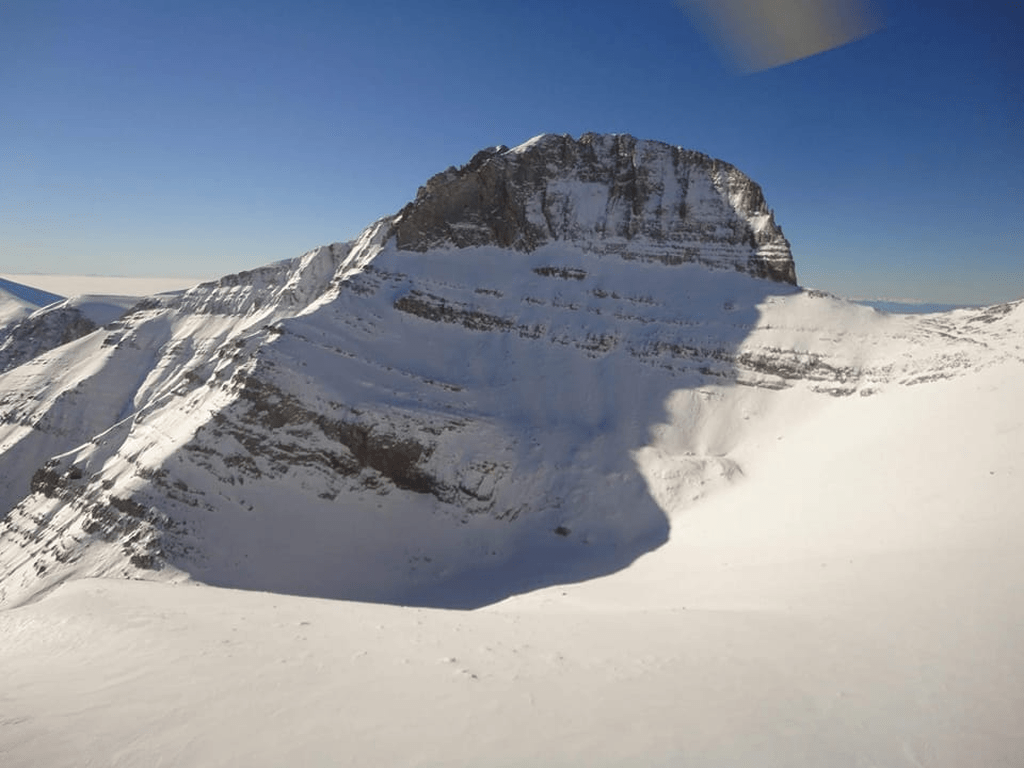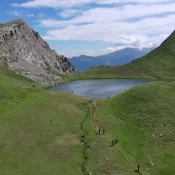
Plateau of the Muses
Plateau of the Muses
At first, I had heard about the Plateau of the Muses, a destination that I never considered a difficult goal. In my mind, the Plateau was just a resting point, a stop before reaching the summit. But that changed during Christmas 2004, when we decided to climb Mount Olympus. It was then that the Plateau revealed its true nature: a destination full of challenges, not just for the body but also for the mind.
But Christmas 2004 was different. Snow covered every inch of the trail, and the Plateau looked like an immense, white desert. The weather changed abruptly, temperatures were extreme, and the ascent became a battle against the elements of nature. The Plateau was no longer just a point along the route. It was the destination, an unpredictable and impressive landscape that demanded respect and strength.
However, I will return to the story of the Plateau and Christmas 2004 in another narration. That experience, so intense and unique, deserves to be told on its own, with all the details that accompany it. Because the Plateau of the Muses that winter was not just a destination but an experience that left a deep mark on my memory and shaped the way I see the mountain and mountaineering. But that story will have to wait for the right moment.
My first ascent to the Plateau had taken place years before, in 1995. Back then, as a young mountaineer, I climbed full of enthusiasm, seeing the mountain as an adventure that could not defeat me. Fatigue didn’t matter, the cold was simply part of the experience, and the difficulties seemed small compared to the feeling of freedom. For me, the Plateau was simply a stop on the way to the summit of Mytikas.
To return to our story, the first time I reached the Plateau of the Muses, after a long and exhausting ascent, I felt every step as if it were a test of endurance and patience. My first backpack weighed at least 25 kilos, and its weight pulled me back, while my body struggled to keep up with the uphill path. It was a novel experience, a combination of excitement and fatigue, with the weight of the backpack reminding me how unprepared I was for the challenge that lay ahead.
As I slowly climbed toward the Plateau, the air grew colder, and the landscape around me began to change. The wooded slopes gave way to barren, alpine expanses, with the gray rock of Olympus dominating the scene. Each step was heavier than the last, yet each time I looked up, I saw the end getting closer—the Plateau, like a natural embrace of the mountains, was calling me to reach it.
When I finally stepped onto the Plateau, I felt a strange sense of freedom. It was as if the weight of the backpack and all the fatigue that accompanied me had magically disappeared. For the first time, I gazed at the peaks of Olympus up close, and that image remained etched in my memory forever.
The magic and energy that one experiences upon reaching the Plateau of the Muses is something unique, beyond description. It is one of the few places that manages to fill you with both awe and serenity at the same time. It’s as if you are standing between two worlds, where the earthly and the divine coexist. The rugged peaks of Olympus surround you, while the cold, crisp air brings a sense of renewal and freedom that few places in the world can offer.
Every spot on the Plateau has its own story, its own energy. The ground seems to pulsate beneath your feet, while the landscape makes you feel small in the face of nature’s grandeur, yet at the same time filled with strength. It is a place where time seems to stand still, and every breath you take brings you closer to the essence of the mountain and yourself.
Those who have stood on the Plateau know well that it is not just a point of ascent, but a place where nature challenges you to connect with something deeper. There, among the highest peaks of Greece, the energy of Olympus envelops you, making you feel the presence of a primordial force that refuses to let you forget it.
The images remain indelible through the passage of time, as do the scents, which seem to rise up every time I recall the Plateau of the Muses. I don’t know if I was biased, wanting so much to experience the magic of this place, or if indeed the magic of the site and the images surrounding it remain so unique. Perhaps it’s a bit of both.
Every step on the Plateau imprinted something new in my memory—the rough texture of the rock, the clarity of the air, the gentle rustling of the wind that seemed to carry stories from centuries past. The colors, the lights and shadows, the changes in the sky, all formed a scene so vivid and real that it felt like I was standing at the center of a mythical world.
Perhaps the magic of the Plateau lies precisely there—in its ability to connect a person with something deeper, beyond everyday life. It is a place that invites you to let go, to experience it without preconditions, and in return, it rewards you with images and sensations that cannot fade over time.
The Plateau of the Muses is one of the most famous and impressive areas of Mount Olympus, located at an altitude of about 2,600 meters. It is surrounded by the highest peaks of the mountain, such as Mytikas (2,918 m) and Stefani (2,909 m), also known as the “Throne of Zeus.” The plateau is a natural highland with an incredible view and is a popular destination for mountaineers attempting the ascent to the peaks of Olympus.
Historical Significance
The name “Plateau of the Muses” comes from the Muses of Greek mythology, the goddesses of the arts and sciences, who according to the ancient Greeks, had their place on the mountain of the gods. This area embodies the connection of Olympus with ancient Greek tradition, and the beauty of the landscape seems almost divine.
There are many reasons to reach the Plateau of the Muses, as the experience offers unique beauty, challenge, and a sense of achievement. Here are a few reasons to attempt the ascent to the Plateau:
Stunning Nature and View
The Plateau of the Muses offers incredible panoramic views of the highest peaks of Olympus, such as Mytikas and Stefani, as well as the entire region of Macedonia and Thessaly. The natural richness of the area, with its alpine meadows, rocky passages, and impressive geology, creates a magical landscape that few places in Greece can match.
Mythological Significance
Olympus is known as the “mountain of the gods” in Greek mythology, and the Plateau of the Muses is believed to have been the place where the Muses, the goddesses of the arts and science, resided. The ascent to this point brings you closer to this rich mythological heritage and the profound cultural significance of the mountain.
Gateway to the Highest Peaks
The Plateau of the Muses is the ideal starting point for the final ascent to the highest peaks of Olympus, Mytikas (2,918 m) and Stefani (2,909 m), also known as the “Throne of Zeus.” From here, climbers continue toward the legendary Gully of Mytikas to reach the highest peak in Greece.
Tranquility and Escape from Everyday Life
The ascent to the Plateau offers you the opportunity to escape from the stress and tension of daily life, providing peace and tranquility in a natural environment far from civilization. The combination of fresh air, alpine landscape, and isolation makes the Plateau of the Muses ideal for spiritual rejuvenation.
Photography Opportunities
For photography enthusiasts, the Plateau of the Muses and the peaks of Olympus offer countless opportunities to capture breathtaking images from the highest points in Greece. The sunrises and sunsets, the shadows of the mountains, and the crystal-clear skies create a perfect setting for stunning photographs.
Cultural and Environmental Significance
Olympus is one of Greece’s most important ecological treasures, recognized as a national park since 1938. The Plateau is home to rich alpine flora and fauna, as well as significant ecosystems that provide a refuge for many rare species of animals and plants.
Mountain Shelters
On the Plateau of the Muses are two of the most well-known shelters on Olympus: the “Yosos Apostolidis” shelter and the “Christos Kakkalos” shelter. These shelters provide accommodation and assistance to mountaineers attempting to climb the mountain’s peaks. They are ideal resting points before the ascent to Mytikas or Stefani.
Access and Ascent
Access to the Plateau of the Muses can be made either from the “Spilios Agapitos” shelter via the Prionia – Shelter route or through other trails leading from the lower altitudes of the mountain. The ascent is demanding but offers unique views of the natural landscape, with stunning vistas of the surrounding peaks.
What to Watch For
The mountaineering route to the Plateau of the Muses, although a summer journey, remains challenging due to the altitude and variety of weather conditions. Proper preparation, equipment, and, if possible, the guidance of experienced mountaineers or guides are recommended.
The Plateau of the Muses is a magical destination that combines history, mythology, and natural beauty, making it one of the most impressive stops for any mountaineer on Olympus.
There are several trails leading to the Plateau of the Muses, offering various options for climbers depending on their experience and physical condition. Here are some of the most well-known routes:
Trail from Prionia – Spilios Agapitos Shelter – Plateau of the Muses
This is the most popular route for ascending to the Plateau of the Muses. The trail starts from Prionia (1,100 m), which is accessible by car. From Prionia, the path leads to the Spilios Agapitos shelter (2,100 m), where climbers can take a break or spend the night. From there, it continues to the Plateau via a steep but impressive route that offers stunning views.
Difficulty: Moderate to difficult, with a demanding ascent towards the end.
Trail from Gortsia – Plateau of the Muses
An alternative and also popular route is the one that starts from Gortsia (1,100 m). This trail is slightly longer than the one from Prionia but offers a beautiful and diverse landscape, passing through forests, gorges, and meadows. The trail initially leads to the “Petrostrouga” shelter and then heads towards the Plateau of the Muses.
Difficulty: Moderate, but longer in duration.
Tags





